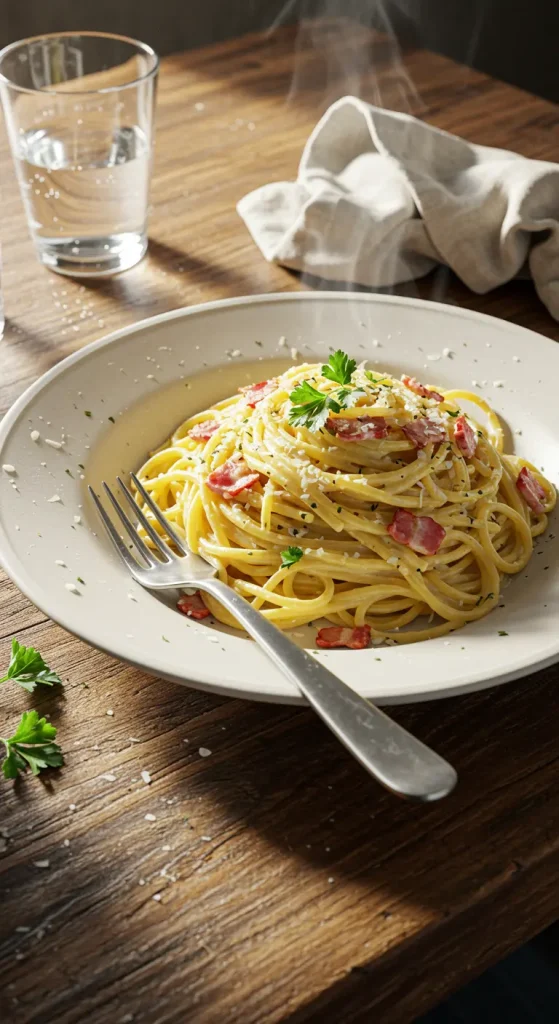Few dishes capture the soul of Italian comfort food like pasta carbonara. It’s simple yet indulgent, rich yet balanced.
With just a handful of ingredients, this Roman classic transforms into a silky, flavorful meal that feels luxurious without being complicated.
What makes carbonara truly special is that it relies on technique rather than heavy sauces — the creamy texture comes not from cream but from eggs, cheese, and the heat of the pasta. If you’ve ever wanted to master this timeless dish, here’s everything you need to know.
Carbonara Recipe
Carbonara is a traditional Roman pasta dish made with spaghetti, guanciale (cured pork jowl), eggs, Pecorino Romano cheese, and freshly cracked black pepper.
It’s famous for its creamy, golden sauce that clings to every strand of pasta.
Unlike many modern variations, authentic carbonara never calls for cream — the creaminess comes from skillful mixing of eggs and cheese with the hot pasta.

Ingredients
- 400 g (14 oz) spaghetti (or another long pasta like rigatoni or bucatini)
- 150 g (5 oz) guanciale (substitute pancetta if unavailable)
- 3 large eggs + 1 yolk
- 1 cup freshly grated Pecorino Romano cheese
- Freshly ground black pepper (to taste)
- Salt (for pasta water)
Instructions
Step 1: Prepare the Guanciale
Start by cutting the guanciale into small strips or cubes. Place it in a large skillet over medium heat. Let the fat slowly render out as the guanciale turns golden and crisp.
This step is crucial because the rendered fat will coat the pasta and help create the signature silky sauce. Once crispy, remove the pan from the heat and set it aside while you cook the pasta.
Step 2: Cook the Pasta
Bring a large pot of salted water to a rolling boil and cook the spaghetti until just shy of al dente. Remember to reserve at least one cup of the starchy pasta water before draining.
This water will help adjust the texture of the sauce later.
Step 3: Make the Egg and Cheese Mixture
In a bowl, whisk together the eggs, egg yolk, and grated Pecorino Romano. Add a generous amount of freshly ground black pepper.
The mixture should be creamy and thick, resembling a paste. This is the foundation of your carbonara sauce.
Step 4: Combine Everything
Return the pan with guanciale to very low heat. Add the drained pasta directly to the pan, tossing it to coat in the rendered fat.
Now comes the most important part: remove the pan from direct heat and slowly pour in the egg-cheese mixture, tossing constantly so the eggs thicken gently without scrambling.
Add a splash of reserved pasta water as needed until the sauce reaches a glossy, velvety consistency that coats the pasta beautifully.
How to Serve It
Carbonara is best served immediately while it’s hot and creamy. Pile the pasta high in warm bowls, top with extra Pecorino Romano, and finish with a final twist of freshly ground black pepper.
A crisp green salad or a glass of dry white wine makes a perfect accompaniment, but honestly, carbonara is so satisfying it can stand alone as the star of the meal.
Conclusion
A true carbonara recipe is all about simplicity, quality ingredients, and the right technique. No cream, no shortcuts — just pasta, guanciale, eggs, cheese, and pepper working together in harmony.
When done correctly, the result is pure Italian comfort in a bowl: rich, creamy, and deeply satisfying.
Once you’ve mastered the balance of heat and timing, you’ll have a dish you can return to again and again, whether for a quick weeknight dinner or to impress guests with authentic Roman flavor.